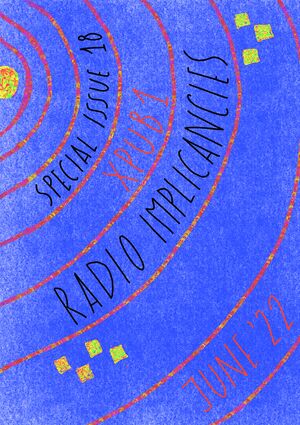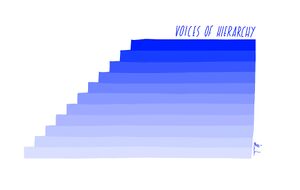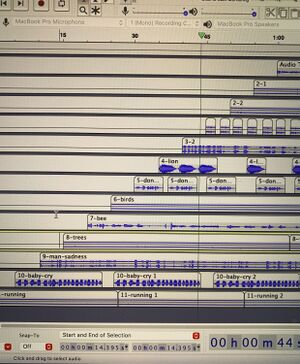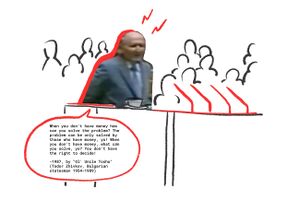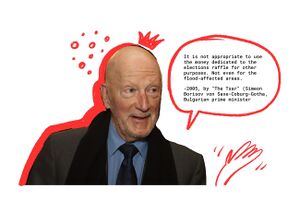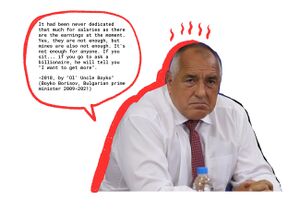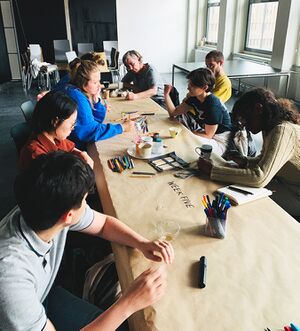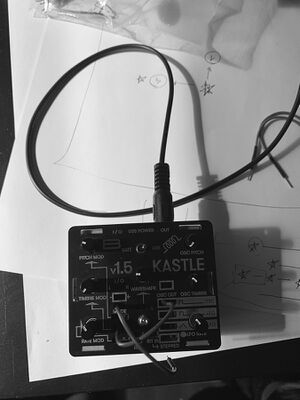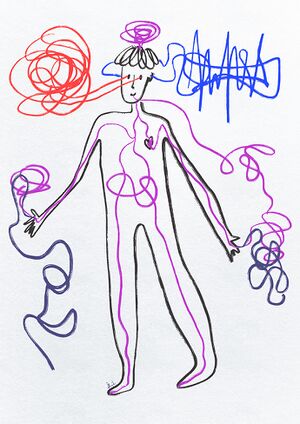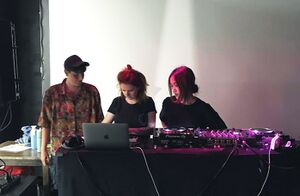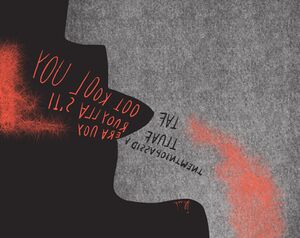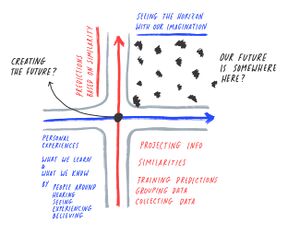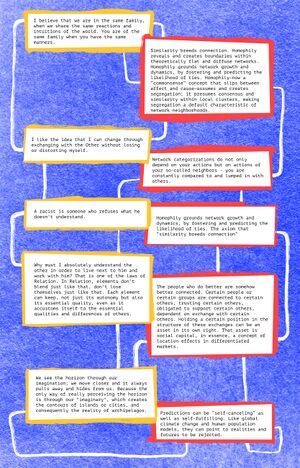Special Issue 18 Work: Difference between revisions
(Created page with "<div style=" font-family: PT Mono; font-size: 14px; "> [https://pzwiki.wdka.nl/mediadesign/User:%C3%85lnik ''back to Ål's page'']") |
|||
| (237 intermediate revisions by the same user not shown) | |||
| Line 1: | Line 1: | ||
<div style=" | <div style=" | ||
font-family: PT Mono; | font-family: PT Mono, Courier, monospace; | ||
font-size: 14px; | font-size: 14px; | ||
"> | "> | ||
[https://pzwiki.wdka.nl/mediadesign/User:%C3%85lnik ''back to Ål's page''] | [https://pzwiki.wdka.nl/mediadesign/User:%C3%85lnik ''back to Ål's page''] | ||
== <span style="color: white; font-family: Menlo; text-decoration:none; background-color: #0033ff; padding-top: 0.1vw; padding-bottom: 0.1vw; padding-left: 0.1vw; padding-right: 0.2vw;">Concept </span>== | |||
[everything is interconnected] [implication] [responsibility] [relationality] [becoming] [interdependency] [resonance] [interference] [entanglement] [techno-ecology] | |||
[[File:Si18-radio-implicancies.jpg|thumb]] | |||
== <span style="color: white; font-family: Menlo; text-decoration:none; background-color: #0033ff; padding-top: 0.1vw; padding-bottom: 0.1vw; padding-left: 0.1vw; padding-right: 0.2vw;">Weekly </span>== | |||
* '''week 00 [prep & setup + covid as an extra]''' | |||
introduction to the special issue topic & process<br> | |||
personal introductions: bio by using interconnections; also later on with less/no "my", "I" [by Femke]<br> | |||
''My parents wanted to have a boy after already having two daughters. They were so sure it will be a boy and decided to name it Alexander. | |||
''I self-trained and created by practice in visual translation - putting complex concepts and ideas into images. My creations are part of who I am and I am part of my creations. | |||
''I am where I am because I was always struggling with the social constructs I was expected to follow - never fitting into 9-5 jobs or following a traditional educational path.'' | |||
''Since childhood I was discouraged to pursue a path in art, that is why it took me so long to get here :D But I got quite some various skills on the way connected to marketing, entrepreneurship, music, djing, dancing, drawing, designing...'' | |||
''After I participated in a training in France, I became part of an association there that gave me the opportunity to completely change my path and be able to navigate it. And with them, to create space for others to gather, experiment with topics and tools they are passionate about.'' | |||
''My need of establishing my practice and focusing brought me here.'' | |||
<br> | |||
terminology & technical setup of the studio that I missed<br> | |||
self-isolation & covid... #canceleverything<br> | |||
'''[pads]''' [https://pad.xpub.nl/p/alnik-si18-week00 personal], [https://pad.xpub.nl/p/SI18_zero special issue], [https://pad.xpub.nl/p/SI18_prototypology prototypology]<br> | |||
* '''week 01 [listening to our first contributions, editing on Audacity, notation]''' | |||
first contributions, listening<br> | |||
prototyping: editing sound, effects on Audacity<br> | |||
writing, reading: notations - theory & experiments <br> | |||
work in group for next week: w/ Gersande and Carmen<br> | |||
'''[pads]''' [https://pad.xpub.nl/p/alnik-si18-week01 personal], [https://pad.xpub.nl/p/SI18_one special issue & prototyping], [https://pad.xpub.nl/p/Problemsofnotation-for_annotation reading&writing], [https://pad.xpub.nl/p/notation_experiment_0420 notation experiments], [https://hub.xpub.nl/soupboat/pad/p/notations_al_carmen_grgr notations w/ carmen & grgr]<br> | |||
* '''week 02 [exploring terminal & pen plotter, weekly release: uneven patterns]'''<br> | |||
prototyping with terminal & pen plotter printer<br> | |||
uneven patters release<br> | |||
publication launch of Floor's Yin Yang [and I am participating with a visual]<br> | |||
'''[pads]''' [https://pad.xpub.nl/p/alnik-si18-week02 personal], [https://pad.xpub.nl/p/SI18_two group] | |||
* '''week 03 [in Sofia, got ill]'''<br> | |||
during this week I didn't follow up the classes because I got post-covid infection of my sinuses, throat and tonsils<br> | |||
* '''week 04 [in Sofia, getting better, care-taker of the next release]'''<br> | |||
'''[pads]''' [https://pad.xpub.nl/p/alnik-si18-week04 personal], [https://pad.xpub.nl/p/SI18_four group], [https://pad.xpub.nl/p/FIVE_proposalfortakecarers care-taking prep], [https://pad.xpub.nl/p/FIVE_editorial editorial invitation], [https://pad.xpub.nl/p/FIVE_supial contribution] | |||
* '''week 05 [catching up, weekly release of Nested Narratives]'''<br> | |||
care-taker of the weekly release with Supi & Em <br> | |||
co-facilitated a collective drawing experience for the group <br> | |||
weekly reading: guest Elodie introduced a documentary Conversations with Edouard Glissant<br> | |||
'''[pads]''' [https://pad.xpub.nl/p/alnik-si18-week05 personal], [https://pad.xpub.nl/p/SI18_five group]<br> | |||
* '''study week [moving to a new apartment in rotterdam, again]'''<br> | |||
meeting w/ Michael<br> | |||
reading assignment by Femke - [https://pzwiki.wdka.nl/mediadesign/Special_Issue_18_Work#03._Intersections_.2F_individual_work_.5BFemke.27s_class.5D_.5Bstudy_week.5D "Our future is somewhere here"]<br> | |||
work on weekly contribution w/ Mitsa <br> | |||
moving to a new apartment <br> | |||
'''[pads]''' [https://pad.xpub.nl/p/alnik-si18-studyweek personal] | |||
* '''week 06'''<br> | |||
diffractive cookbook method contribution w/ Mitsa finalised & presented <br> | |||
presented my first two zines at Zine Camp Sessions at WORM<br> | |||
taking a break from week 07's release<br> | |||
'''[pads]''' [https://pad.xpub.nl/p/SIX-diffractive-cookbook diffractive cookbook] | |||
* '''week 07'''<br> | |||
* '''week 08'''<br> | |||
Paris residency with the whole group | |||
recordings of the last release | |||
experimental concert with Harold Schellinx | |||
dj mixing session w/ Supi & Mitsa + prep for the live mix at the grad show | |||
xpub2 grad show + live diffractive mixing | |||
== <span style="color: white; font-family: Menlo; text-decoration:none; background-color: #0033ff; padding-top: 0.1vw; padding-bottom: 0.1vw; padding-left: 0.1vw; padding-right: 0.2vw;">Contributions </span>== | |||
=== <span style="color: white; font-family: Menlo; text-decoration:none; background-color: #ff0033; padding-top: 0.1vw; padding-bottom: 0.1vw; padding-left: 0.1vw; padding-right: 0.2vw;">week 01 - field recording, glitch editing w/ audacity [work w/ Emma] </span>=== | |||
'''[about]''' During the creation time for our first contribution, I was self-isolating at home because of covid; and Emma was visiting her family in Belgium. Emma suggested the idea and she later mixed the recordings so we can hear the two recordings merged. It is an interesting contrast between her being at a different place every time, whereas I was being in the same space where there was not much happening.<br> | |||
'''[field recording]''' We did several field recordings of the time and place we were at some given moments. The field recording format was [1] introduction of time and place; and [2] recording of the sounds in the space. We also took one photo of that moment. <br> | |||
'''[photo glitching with audacity]''' I became interested how Audacity can be used to create glitched images. Thus, I experimented with that on the documentation photos we took using [https://www.youtube.com/watch?v=-nHdHfL8L_Y this tutorial] as a base (and a few more). <br> | |||
[[File:15042022-1800.jpg|frameless]] [[File:16042022-1500.jpg|frameless]] [[File:14042022-1630.jpg|frameless]] [[File:14042022-2100.jpg|frameless]] | |||
[[File:17042022-1530.jpg|frameless]] [[File:16042022-2000.jpg|frameless]] [[File:15042022-1000.jpg|frameless]] | |||
=== <span style="color: white; font-family: Menlo; text-decoration:none; background-color: #ff0033; padding-top: 0.1vw; padding-bottom: 0.1vw; padding-left: 0.1vw; padding-right: 0.2vw;">week 02 - Uneven Patterns: Are We On The Same Page? [work w/ Gersande & Carmen] </span>=== | |||
'''[concept]''' Uneven Patterns <br> | |||
'''[title]''' Are We On The Same Page?<br> | |||
'''[documentation]''' [https://pzwiki.wdka.nl/mediadesign/Category:Prototypology#Carmen_.26_Gersande_.26_Alex here] <br> | |||
'''[about]''' Following a blank script, we recorded observations of what was happening around us and our thoughts to create a real fictional space.<br> | |||
'''[recording]''' [https://hub.xpub.nl/soupboat/SI18/02/recordings/are-we-on-the-same-page_gersande-carmen-alex.mp3 listen here] | |||
=== <span style="color: white; font-family: Menlo; text-decoration:none; background-color: #ff0033; padding-top: 0.1vw; padding-bottom: 0.1vw; padding-left: 0.1vw; padding-right: 0.2vw;">week 03 - Voices Of Hierarchy [individual work] </span>=== | |||
<br> | |||
[[File:voices-of-hierarchy-notation-web.jpg|thumb]] | |||
'''[about]''' this experiment was triggered by Femke's week 02 class. We have read part of the chapter ''Language and mattering humans'' [''Animacies: Biopolitics, Racial Mattering, and Queer Affect''] and talked about objects and subjects animacy hierarchy in grammar: | |||
Perhaps the broadest cross-linguistic study of animacy hierarchies was done by John Cherry. Cherry’s study, representing several language families and including Swahili, English, Navajo, Shona, Chi- nook, Algonquian, Hopi, Russian, Polish, and Breton, yielded a summary that roughly characterizes each station (with its own hierarchical orders) in an animacy hierarchy, and offered perhaps the most detailed summary of its kind. | |||
This schema asserts that an adult male who is “free” (as opposed to enslaved), able-bodied, and with intact linguistic capacities, one who is also familiar, individual, and positioned nearby, stands at the top of the hierarchy as the most “animate” or active agent within grammars of ordering. | |||
Lower down, and hence less agentive, would be, for example, a large, distant population of females. Lower still would be nonhuman animals (ranked by size). Near the bottom would be something like “sadness.” | |||
''-Mel Y. Chen, page 26-27'' <br> | |||
For this experiment, I took some random voices and ordered them following the hierarchical order presented by Mel Y. Chen and John Cherry. The loudest voice is the one on the top of the [sound] hierarchy as well - it has the highest volume. <br> | |||
[[File:Voices-of-hierarchy.jpg|thumb]] | |||
Voices are of:<br> | |||
# a white man with British accent [unfamiliar man] | |||
# Alex [me, a familiar white woman] | |||
# a white woman with American accent [unfamiliar woman] | |||
# a kid [nonadult] | |||
# a lion [largest animal] | |||
# a donkey [larger animal] | |||
# some birds [animal] | |||
# a bee [insect] | |||
# trees' leaves [plant] | |||
# a man crying [emotion] | |||
# a sound of someone running [activity] | |||
<br> | |||
'''[process]'''<br> | |||
-after re-reading the chapter and checking John Cherry's book and his representation of the hierarchy, I collected the sounds I needed [all of them are copyright free samples + my own recording of my voice]<br> | |||
-the audio samples were put on audacity and ordered sorted to the hierarchal order<br> | |||
-from down to up, I adjusted the starting time of each sample and its volume<br> | |||
-applied several edits to adjust the balance, got rid of two samples<br> | |||
'''[result]'''<br> | |||
▶ [https://hub.xpub.nl/soupboat/~alnik/xpub1/lab/si18/week03/voice-hierarchy-week03.mp3 listen to the recording here]<br> | |||
▶ [https://hub.xpub.nl/soupboat/~alnik/xpub1/lab/si18/week03/voices-of-hierarchy-notation-web.jpg notation]<br> | |||
=== <span style="color: white; font-family: Menlo; text-decoration:none; background-color: #ff0033; padding-top: 0.1vw; padding-bottom: 0.1vw; padding-left: 0.1vw; padding-right: 0.2vw;">week 04 - Getting Political: Money Talks [work w/ Mitsa] </span>=== | |||
[[File:01-bai-tosho.jpg|thumb]] | |||
[[File:02-tsaria.jpg|thumb]] | |||
[[File:03-bate-boyko.jpg|thumb]] | |||
'''[about]''' for this week's topic, that was "Parliament", with Mitsa we decided to get political. We [https://pad.xpub.nl/p/SI18_four_almitsa brainstormed some ideas] and decided to do parallel pieces connected to political representation. Mitsa is doing remixes of national anthems in a robotic sounding. I was looking through some iconic quotes of Bulgarian leaders during the Bulgaria's transition to democracy and market economy. There are three quotes by three statesmen: | |||
<br> | |||
'''Todor Zhivkov (Statesman 1954-1989)''', also called "Ol' Uncle Tosho" <br> | |||
He was a Bulgarian communist statesman who served as the de facto leader of the People's Republic of Bulgaria (PRB) from 1954 until 1989 as General Secretary of the Bulgarian Communist Party.<br><br> | |||
'''Simeon Borisov von Saxe-Coburg-Gotha (Bulgarian prime minister 2001-2005)''', but also the last tsar of the Kingdom of Bulgaria as Simeon II from 1943 until 1946 (with a regent, because he was 6 years old when his father died). <br><br> | |||
'''Boyko Borisov (Bulgarian prime minister 2009-2021)''' who was before that Mayor of Sofia. | |||
<br> | |||
'''[process]''' the first quote I selected was Zhivkov's one about money. Then, I was mainly looking for other quotes that are tackling the topic of money. When the politicians were saying those things, they were speaking in a vernacular manner, not using any high and official language. <br> | |||
Zhivkov and Borisov's quotes are also recorded on video. Saxe-Coburg-Gotha's quote is from a newspaper. I translated their quotes in English and then recorded them with my Mac's Spoken Content option using the voice of Daniel. Then, added some applause at the end. | |||
'''[result]'''<br> | |||
▶ Todor Zhivkov: [https://www.youtube.com/watch?v=dK1TBBmwqsQ original quote] vs. [https://hub.xpub.nl/soupboat/SI18/04/contributions/Bai-Tosho-Todor-Zhivkov.mp3 the recording]<br> | |||
▶ "The Tsar" Simeon Borisov von Saxe-Coburg-Gotha: [https://hub.xpub.nl/soupboat/SI18/04/contributions/The-Tsar.mp3 the recording]<br> | |||
▶ Boyko Borisov: [https://youtu.be/7aNrz1X8dGY?t=11 original quote] vs. [https://hub.xpub.nl/soupboat/SI18/04/contributions/Boyko-Borisov.mp3 the recording] | |||
=== <span style="color: white; font-family: Menlo; text-decoration:none; background-color: #ff0033; padding-top: 0.1vw; padding-bottom: 0.1vw; padding-left: 0.1vw; padding-right: 0.2vw;">week 05 - Nested Narratives: What Is Left To Discuss? </span>=== | |||
==== 05_01_ Care-taking & Editorial [work w/ Emma & Supi] ==== | |||
'''[concept]''' this week's contribution theme came from ideas by each one of us and merged into the title of ''Nested Narratives: What Is Left To Discuss?'' | |||
<br> | |||
▶ refrain<br> | |||
▶ collective writing<br> | |||
▶ nested narratives<br> | |||
'''[invitation for the group]''' | |||
<br> | |||
The release of this week will be an experiment with collaborative writing for the radio: you will be writing a piece of text that will then be recorded and edited by you. The structure is built upon a refrain that will produce different scenarios and visions with the same beginning or end. We chose a method that is inter-dependent, inter-connected and collaborative, but at the same time allows everyone to work at their own pace and time.<br> | |||
▶ [https://pad.xpub.nl/p/FIVE_editorial full invitation here]<br> | |||
'''[mix and sequence]''' | |||
<br> | |||
[[File:Five-release.jpg|thumb]] | |||
In order to mix the piece in the best way possible, we tried and played various scenarios. We took into consideration the dynamic of the contributions, their content and intention, their topic and form. Finally, we decided that what would work best for the listening experience is to start with an example of censorship, continue with a collective poem on art and censorship, and followed by a piece that questions it. Then, a conversation piece on self-censoring in our art practice and ending with dynamic and powerful spoken words and melodic contribution.<br> | |||
[[File:Week-five-sequences.jpg|frameless]]<br> | |||
'''[interface]''' Supi was taking care of the interface and we were brainstorming about various solutions how to organise the content. After we received the texts, we started thinking about how can we organise the sequence visually - tried nesting, as a list, as a map. However, as soon as we got the recordings, we had to change our approach - there were many new elements to take into consideration before deciding on the sequence and the interface. | |||
<br> | |||
'''[release]''' The listening experience was quite important for us. We wanted not to show the website and people to watch a screen while listening to the broadcast, thus we facilitated a collective drawing moment. We invited everyone to sit together on a table and reflect on what they're hearing by sketching, doodling, writing and drawing. <br> | |||
'''[wip]''' <br> | |||
▶ [https://pad.xpub.nl/p/FIVE_proposalfortakecarers care-takers working place]<br> | |||
▶ [https://pad.xpub.nl/p/FIVE_editorial editorial proposal to the group] <br> | |||
==== 05_02_ Contribution: What's Left To Discuss? [work w/ Supi] ==== | |||
[[File:Week05-alsu.jpg|thumb]] | |||
'''[title]''' What Is Left To Discuss? | |||
'''[duration]''' 3:05 min | |||
'''[description]''' A conversation piece about art: what is it for us, as makers, how do we censor ourselves and why. | |||
'''[input]''' audio recording of our voices; audio recording of noise made with Kastle | |||
'''[tools]''' Kastle, Macbook pro, Zoom, Audacity | |||
'''[process log]''' <br> | |||
# We started with some [https://pad.xpub.nl/p/FIVE_supial collective writing]. The idea was to create a conversation by asking each other questions and answering them. We had an empty script with each of us writing something one after another. | |||
# The text was created over 3 days. We both asked each other questions and answered them. | |||
# Then, we recorded our conversation using an online call. | |||
# In order to add an underscore, we produced various noises on Kastle at Supi's restaurant. Used one of them, looped it and added it to the mix. | |||
# We had the idea to censor parts of our conversation. However, while listening to it, we decided to keep it as it is. It became a quite honest and open conversation and we shared things we wouldn't normally say in a conversation outside this setting. <br> | |||
'''[output]''' <br> ▶ [https://hub.xpub.nl/soupboat/SI18/05/texts/alsu.txt text] <br> | |||
▶ [https://hub.xpub.nl/soupboat/SI18/05/recordings/what-is-left-to-discuss_alsu.mp3 recording] | |||
=== <span style="color: white; font-family: Menlo; text-decoration:none; background-color: #ff0033; padding-top: 0.1vw; padding-bottom: 0.1vw; padding-left: 0.1vw; padding-right: 0.2vw;">week 06 - Diffractive Reading [work w/ Mitsa] </span>=== | |||
[[File:Diffractive-perception-3.jpg|thumb]] | |||
'''[title]''' Diffracted Narrations <br> | |||
'''[description]''' This simple recipe for diffractive perception of information provided by two sources can be used on various types of pieces. However, one of the inputs should be a video and the other one - a written text. We create a new piece by muting the original narration of the video and adding a completely different one. This method allows us to experiment on conceptual level: what types of stories or thoughts we would like to play with? By experiencing one source through the other, creative and unexpected readings can emerge. <br> | |||
'''[input]''' Video and written text. In our experiment we used Denise Fereira Da Silva, Arjuna Neuman (2019), Four waters: deep implicancy as a video source and two poems by Parwana Amiri: Y''our Eyes Bother Us'' and ''How Hard'' <br> | |||
'''[tools]''' computer, mobile phone <br> | |||
'''[process log]'''<br> | |||
▶ [https://pad.xpub.nl/p/SIX-almitsa process pad] | |||
# Pick two pieces: | |||
-one video (ideally without subtitles and texts on it)<br> | |||
-a written text (article, poem, short story etc.)<br> | |||
# Video: if the video has audio, mute it | |||
# Text: | |||
-choose part of the written text that you would like to add as a new voice over of the video<br> | |||
# Perform the new piece by playing the video and narrating it live yourself | |||
# Record the performance with video & audio | |||
<br> | |||
As a result, you will have a new piece with a diffracted narration. <br> | |||
'''[output]''' Our diffracted narration - [https://hub.xpub.nl/soupboat/~alnik/xpub1/lab/si18/week06/diffracted-narrations-result-almitsa.mp4 one of the takes] (not the final choice of poems).<br> | |||
'''[reads]''' Denise Fereira Da Silva, Arjuna Neuman (2019), Four waters: deep implicancy | |||
<br>Parwana Amiri (2019-2020), Your Eyes Bother Us and How Hard | |||
=== <span style="color: white; font-family: Menlo; text-decoration:none; background-color: #ff0033; padding-top: 0.1vw; padding-bottom: 0.1vw; padding-left: 0.1vw; padding-right: 0.2vw;">week 08 - Residency in Paris at La Generale [whole group work] </span>=== | |||
[[File:Si18-diffractive-mixing.jpg|thumb]] | |||
Paris residency with the whole group <br> | |||
recordings of the last release <br> | |||
[https://unpublic.bandcamp.com/album/paris-22-june-2022?from=fanpub_fb experimental concert with Harold Schellinx] + [http://www.harsmedia.com/SoundBlog/Archief/00880.php more info here]<br> | |||
dj mixing session w/ Supi & Mitsa + prep for the live mix at the grad show<br> | |||
xpub2 grad show + live diffractive dj mix w/ Supi & Mitsa<br> | |||
== <span style="color: white; font-family: Menlo; text-decoration:none; background-color: #0033ff; padding-top: 0.1vw; padding-bottom: 0.1vw; padding-left: 0.1vw; padding-right: 0.2vw;">Experiments </span>== | |||
===<span style="color: white; font-family: Menlo; text-decoration:none; background-color: #ff0033; padding-top: 0.1vw; padding-bottom: 0.1vw; padding-left: 0.1vw; padding-right: 0.2vw;">00. Notations w/ Carmen & Erika [Steve's class] </span>=== | |||
<br> | |||
'''[about]''' During the activity we created notations which should be performed and recorded. Our trio, The Blind-Smashed-Orchestra had several ideas on which we made 5 different try-outs. Finally, we selected two of them: "the blind-smashed orchestra" and the "loop-stretch-cut". ''20/04/2022'' | |||
'''rec 1 blind-smashed-orchestra''' | |||
instructions:<br> | |||
Imagine you are the conductor of an orchestra. Choose some musicians and form a circle with them. | |||
start playing your masterpiece invoking the names of the instruments that will be given to each musician (f.e. you say drums looking at someone and this person will be in charge of the drums) The orchestra is a very special one. An orchestra of flat bodies laying on the ground. Blindfolded. Facing down. So as soon as you name the instrument the person in charge of it will crash on the ground and start improvise imitating that instrument. (you can choose between drums, winds, strings, vocals) <br> | |||
In the end join your musicians on the ground and direct your orchestra! <br> | |||
▶ [https://hub.xpub.nl/soupboat/SI18/notations/BLIND-SMASHED-ORCHESTRA/BSO_1.m4a recording] | |||
<br><br> | |||
'''rec 2 loop-stretch-cut''' | |||
instructions:<br> | |||
In a group of 3 people:<br> | |||
person 1 chooses a word and starts repeating it (as a loop)<br> | |||
person 2 waits a bit and starts stretching the word (as if it is stretched on Audacity)<br> | |||
person 3 waits a bit and starts to perform cuts of the word (as if it's cut on Audacity)<br> | |||
keep the performance for a while :-)<br> | |||
''a special tribute to Manetta's homework assignment'' <br> | |||
▶ [https://hub.xpub.nl/soupboat/SI18/notations/BLIND-SMASHED-ORCHESTRA/BSO_2.m4a recording] | |||
<br> | |||
'''rec Covers''' | |||
We also did three covers of notations by Miriam and Emma:<br> | |||
Imagine you're the owner of a café and your coffee machine just broke down. You try imitating the sounds of a coffee machine so the customers won't notice that the coffee machine broke. ▶ [https://hub.xpub.nl/soupboat/SI18/notations/MIRIEM/ME_09_COVER-by-Blind-Smashed-Orchestra.MOV recording] | |||
<br> | |||
Hum the sound of a commercial jingle you know but with your mouth open. ▶ [https://hub.xpub.nl/soupboat/SI18/notations/MIRIEM/ME_17_COVER-by-Blind-Smashed-Orchestra.m4a recording] | |||
<br> | |||
Stare at the sun without sunglasses. Describe the feeling in a calm and juicy way. | |||
▶ [https://hub.xpub.nl/soupboat/SI18/notations/MIRIEM/ME_22_COVER-by-Blind-Smashed-Orchestra.m4a recording] | |||
===<span style="color: white; font-family: Menlo; text-decoration:none; background-color: #ff0033; padding-top: 0.1vw; padding-bottom: 0.1vw; padding-left: 0.1vw; padding-right: 0.2vw;">01. How Does Anxiety Sound Like / individual work [prototyping] </span>=== | |||
[[File:Week01-anxiety-notation.jpg|thumb]]<br> | |||
'''[about]''' Our weekly assignment for the next prototyping class was to make a recording and use one (or more) of the effects on Audacity (repeat/stretch/cut/reverse) following some additional constrain. My first try was actually a longer piece coming from a personal need to explore some sounds and progression. Actually, I used almost all of the effects (except for reverse) for this piece:<br> | |||
▶ [https://hub.xpub.nl/soupboat/~alnik/xpub1/lab/si18/week01/how-does-anxiety-sound/alnik-anxiety.mp3 listen to how does anxiety sound like]<br> | |||
▶ [https://hub.xpub.nl/soupboat/~alnik/xpub1/lab/si18/week01/how-does-anxiety-sound/week01-anxiety-notation.jpg notation]<br> | |||
'''[process]''' The core material is my voice saying "wow". Then, I changed the pitch to 2 levels down; 2 levels up and stretched them both with different rate. I repeated some of them and placed on different tracks, so they can overlap. Lower pitch sounds visualise the first signs of distress and the constant vibration/noise of the body after the climax. Higher pitches depict the moments of panic/histeria/fear or feeling of ''I cannot stand this anymore'' - the climax. Recorded and mixed on Audacity; computer microphone used. | |||
=== <span style="color: white; font-family: Menlo; text-decoration:none; background-color: #ff0033; padding-top: 0.1vw; padding-bottom: 0.1vw; padding-left: 0.1vw; padding-right: 0.2vw;">02. Reversed Words / individual work [prototyping] </span>=== | |||
<br> | |||
[[File:Reversed-words2.jpg|thumb]] | |||
'''[about]''' Have you ever said something to a person you love that you wish you had never said? You cannot take your words back, can you? After doing the first experiment with the Audacity effects, I realised I didn't do anything with the "reverse" effect. I started thinking of what could be interesting to be reversed? Then, I quickly came up with the idea of reversing (as taking back) something you said. How would it sound to "delete" or "take back" what you said and immediately regretted. Here are some quick experiments:<br> | |||
▶ listen to [https://hub.xpub.nl/soupboat/~alnik/xpub1/lab/si18/week01/reversed-words/week01-reversed-words.mp3 reversed words]<br> | |||
▶ [https://hub.xpub.nl/soupboat/~alnik/xpub1/lab/si18/week01/reversed-words/reversed-words-notation.jpg notation] <br> | |||
'''[process]''' First, I recorded my voice saying the three phrases. Then, I made the pitch one level down. Copied them and reversed. There is a tiny overlap between the "proper" phrase and the "reversed" one. There is another track with a slight sound on the background to fill in the silent moments between the three phrases. Recorded and edited on Audacity. | |||
<br> | |||
=== <span style="color: white; font-family: Menlo; text-decoration:none; background-color: #ff0033; padding-top: 0.1vw; padding-bottom: 0.1vw; padding-left: 0.1vw; padding-right: 0.2vw;">03. Intersections / individual work [Femke's class] [study week] </span>=== | |||
[https://pad.xpub.nl/p/alnik-si18-studyweek study week pad] | |||
[[File:Intersection-graph.jpg|thumb]] | |||
[[File:Intersection-dialogue.jpg|thumb]] | |||
<br> | |||
'''[assignment]''' diffractive reading <br> | |||
Pick two resources from the Related Resources page, and read/watch/... them "diffractively" through one another (i.e let them interfere with each other). Prepare a way to share some resonance for the afternoon session on Tuesday 7 June; duration p/p for doing this is maximum 5 minutes: A sound, an image, a quote, a performative response, an object, (it does not have to be durational) ... If you want to, you can take one resource from elsewhere but include at least one from the page. You can also pick materials that we watched/looked at together already. | |||
'''[about]''' '''Intersection: Our future is somewhere here''' <br> | |||
For this assignment I have picked the following reads:<br> | |||
* Conversations with Edouard Glissant [2010] Documentary | |||
* Wendy Hui Kyong Chun [2018] Queerying Homophily | |||
<br> | |||
This is an intersection between two works: thoughts of Edouard Glissant in the 2010's documentary about him and Wendy Hui Kyong Chun's chapter Queerying Homophily. It is based on similarity - what makes us similar and how does it affect the way we live (together). For Glissant, "we are in the same family when we share the same reactions and intuitions of the world (...) when we have the same manners". The roots can be found through poetry or knowledge. It is the common knowledge we accept from our parents and teachers (of any form) when we grow up. From the people we know and the events we experience. Thus, our predictions are "educated guesses" with the support of what we know, have seen, have read, have heard and experienced. When we look at the future, "we see the horizon through our imagination". The future we can create is the one we can imagine. <br><br> | |||
In the intersection of the present moment, we meet Wendy Hui Kyong Chun's collected data and grouped subjects with the help of similarity. Similarity breeds connection. She argues, "Homophily is the mechanism by which individuals “stick” together, and “wes” emerge". Predictions can be made thanks to the trained programmes which work with the collected data. However, "predictions can be “self-canceling” as well as self-fulfilling", she quotes Nate Silver. Thus, there are multiple possible futures. Everyone's imagination is bring one future and we collectively shape our collective future. Ours is somewhere in the fourth quadrant of the graph.<br> | |||
== <span style="color: white; font-family: Menlo; text-decoration:none; background-color: #0033ff; padding-top: 0.1vw; padding-bottom: 0.1vw; padding-left: 0.1vw; padding-right: 0.2vw;">Terminology </span>== | |||
Radio Implicancies is about practicing interdependencies. About how to stay with the complex entanglements between the personal, the economical, the political and the computational. About thinking, using and making technology with mutual relations in mind. | |||
[https://pad.xpub.nl/p/alnik-si18-terminology Full terminology here.] | |||
* '''agential realism''' | |||
According to Barad's theory of agential realism, the universe comprises phenomena, which are "the ontological inseparability of intra-acting agencies". Intra-action, a neologism introduced by Barad, signals an important challenge to individualist metaphysics. | |||
* '''homophily''' | |||
Homophily is the principle that a contact between similar people occurs at a higher rate than among dissimilar people. The pervasive fact of homophily means that cultural, behavioral, genetic, or material information that flows through networks will tend to be localized. | |||
* '''notation''' | |||
A series or system of written symbols used to represent numbers, amounts, or elements in something such as music or mathematics. | |||
== <span style="color: white; font-family: Menlo; text-decoration:none; background-color: #0033ff; padding-top: 0.1vw; padding-bottom: 0.1vw; padding-left: 0.1vw; padding-right: 0.2vw;">Readings </span>== | |||
[https://pad.xpub.nl/p/alnik-si18-reads Reads annotations are here.] <br> | |||
* Barad, Karen (2007). ''Meeting the Universe Halfway: Quantum Physics and the Entanglement of Matter and Meaning'' | |||
* Scratch Orchestra (1969) ''Nature Study Notes '' | |||
* Simon Yuill (2008) ''All Problems Of Notation Will Be Solved By The Masses'' | |||
* Mel Y. Chen (2012) ''Animacies: Biopolitics, Racial Mattering, and Queer Affect'' | |||
* Roc Jiménez de Cisneros & Serafin Alvarez (2022) ''Are Viruses Alive?'' | |||
* Larissa Lai, ''The Tiger Flu (chapter 1 + 2)'' | |||
* Wendy Hui Kyong Chun (2018) ''Queerying Homophily'' | |||
* Conversations with Edouard Glissant (2010) Documentary | |||
* Denise Fereira Da Silva, Arjuna Neuman (2019), ''Four waters: deep implicancy'' | |||
* Parwana Amiri, ''Your Eyes Bother Us'', ''How Hard'' | |||
== <span style="color: white; font-family: Menlo; text-decoration:none; background-color: #0033ff; padding-top: 0.1vw; padding-bottom: 0.1vw; padding-left: 0.1vw; padding-right: 0.2vw;">Reflection </span>== | |||
[https://pad.xpub.nl/p/si18_debrief Group debrief pad] | |||
'''[personal reflection]''' <br> | |||
''▶ structure & group work:''<br> | |||
+weekly releases & structure of work organisation was great - no pressure of staying on one subject/project for long (work in groups of 3 or pairs rocks) <br> | |||
-not having guidance/structure makes us waste too much time in discussions and trying to make it work without leaving anyone out <br> | |||
+care-taking was quite exciting and a really great moment to play editor and experiment with concept<br> | |||
+the rotation of roles is an amazing opportunity to try out different things<br> | |||
-would adjust the weekly programme of days & work (mon prototyping/tue release was a bit difficult especially for care-takers)<br> | |||
<br> | |||
''▶ learning:''<br> | |||
+experimental mode - felt that I had more time and opportunity to try out things than last two trimesters<br> | |||
+absolutely loved the way Femke facilitated the whole process & the sessions; she really has a unique and ultra valuable way to give feedback, put focus on and extract key points<br> | |||
+booklets by Manetta and Joseph were amazing <br> | |||
+weekly documentation really helped to record everything and quickly reflect on it <br> | |||
<br> | |||
''▶ collective moments & networking:''<br> | |||
+Paris was a really great ending of the trimester and the year - it is also an opportunity for a regular collab (also so interesting their portable radio setup and concept, collective)<br> | |||
-going outside to practice and work with venues/collectives is super important<br> | |||
+the way we worked in Paris was really great<br> | |||
<br> | |||
''▶ special issue:''<br> | |||
-addressing urgency was something we didn't really do during our work - we stayed on the safe place of playing with methods without going deeper into a topic; conversation about an issue - but then, we didn't really have time to do it <br> | |||
+but that was also ok - because we/many of us were exhausted from previous SIs and spending too much time on a big topic; maybe what we needed was not a topic, but more like adding more context in the releases; or maybe we didn't need to after all :)<br> | |||
-didn't open our publications to the public and I think we struggled with that during the whole year - we never really worked on how to connect with publics outside our room or bubble and didn't figure out that in our works and publications (at least I feel that) - e.g. in Paris when I saw their mobile radio setup I was talking with Carmen how amazing would it be if we had that <br> | |||
-I would really like to see more of connection with collectives and outside world of how things are applied in reality and made sustainable<br> | |||
-we are coming from different understanding & experience of what is a publication/publishing so a warm up moment in the beginning is essential (because of many reasons - culture, country, practice etc)<br> | |||
-felt disconnected from the prototyping classes this trimester (missed some because I got sick twice, then felt it's quite late to catch up)<br> | |||
-because of the weekly structure - focus on concept & less time for prototyping - usually when the time is short, you always focus on one thing<br> | |||
<br> | |||
''▶ general notes:''<br> | |||
+we had the chance to change the structure for the last month - we decided to keep it as it is (maybe bc we were already tired?)<br> | |||
+a school trip is a must (once per year for both xpub1 and xpub2 I think)<br> | |||
[[Category:Implicancies]] | |||
Latest revision as of 00:54, 5 July 2022
Concept
[everything is interconnected] [implication] [responsibility] [relationality] [becoming] [interdependency] [resonance] [interference] [entanglement] [techno-ecology]
Weekly
- week 00 [prep & setup + covid as an extra]
introduction to the special issue topic & process
personal introductions: bio by using interconnections; also later on with less/no "my", "I" [by Femke]
My parents wanted to have a boy after already having two daughters. They were so sure it will be a boy and decided to name it Alexander. I self-trained and created by practice in visual translation - putting complex concepts and ideas into images. My creations are part of who I am and I am part of my creations. I am where I am because I was always struggling with the social constructs I was expected to follow - never fitting into 9-5 jobs or following a traditional educational path. Since childhood I was discouraged to pursue a path in art, that is why it took me so long to get here :D But I got quite some various skills on the way connected to marketing, entrepreneurship, music, djing, dancing, drawing, designing... After I participated in a training in France, I became part of an association there that gave me the opportunity to completely change my path and be able to navigate it. And with them, to create space for others to gather, experiment with topics and tools they are passionate about. My need of establishing my practice and focusing brought me here.
terminology & technical setup of the studio that I missed
self-isolation & covid... #canceleverything
[pads] personal, special issue, prototypology
- week 01 [listening to our first contributions, editing on Audacity, notation]
first contributions, listening
prototyping: editing sound, effects on Audacity
writing, reading: notations - theory & experiments
work in group for next week: w/ Gersande and Carmen
[pads] personal, special issue & prototyping, reading&writing, notation experiments, notations w/ carmen & grgr
- week 02 [exploring terminal & pen plotter, weekly release: uneven patterns]
prototyping with terminal & pen plotter printer
uneven patters release
publication launch of Floor's Yin Yang [and I am participating with a visual]
[pads] personal, group
- week 03 [in Sofia, got ill]
during this week I didn't follow up the classes because I got post-covid infection of my sinuses, throat and tonsils
- week 04 [in Sofia, getting better, care-taker of the next release]
[pads] personal, group, care-taking prep, editorial invitation, contribution
- week 05 [catching up, weekly release of Nested Narratives]
care-taker of the weekly release with Supi & Em
co-facilitated a collective drawing experience for the group
weekly reading: guest Elodie introduced a documentary Conversations with Edouard Glissant
[pads] personal, group
- study week [moving to a new apartment in rotterdam, again]
meeting w/ Michael
reading assignment by Femke - "Our future is somewhere here"
work on weekly contribution w/ Mitsa
moving to a new apartment
[pads] personal
- week 06
diffractive cookbook method contribution w/ Mitsa finalised & presented
presented my first two zines at Zine Camp Sessions at WORM
taking a break from week 07's release
[pads] diffractive cookbook
- week 07
- week 08
Paris residency with the whole group recordings of the last release experimental concert with Harold Schellinx dj mixing session w/ Supi & Mitsa + prep for the live mix at the grad show xpub2 grad show + live diffractive mixing
Contributions
week 01 - field recording, glitch editing w/ audacity [work w/ Emma]
[about] During the creation time for our first contribution, I was self-isolating at home because of covid; and Emma was visiting her family in Belgium. Emma suggested the idea and she later mixed the recordings so we can hear the two recordings merged. It is an interesting contrast between her being at a different place every time, whereas I was being in the same space where there was not much happening.
[field recording] We did several field recordings of the time and place we were at some given moments. The field recording format was [1] introduction of time and place; and [2] recording of the sounds in the space. We also took one photo of that moment.
[photo glitching with audacity] I became interested how Audacity can be used to create glitched images. Thus, I experimented with that on the documentation photos we took using this tutorial as a base (and a few more).
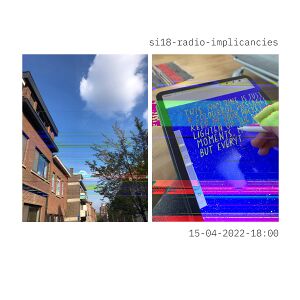
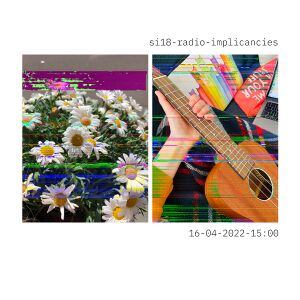
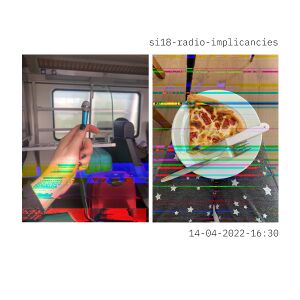
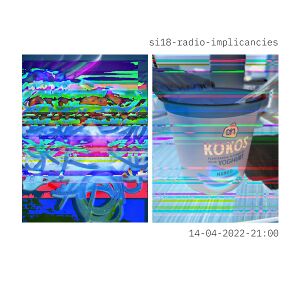
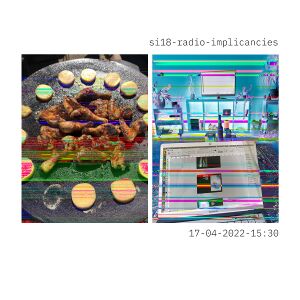
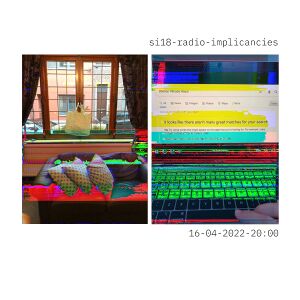
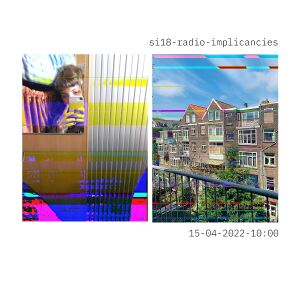
week 02 - Uneven Patterns: Are We On The Same Page? [work w/ Gersande & Carmen]
[concept] Uneven Patterns
[title] Are We On The Same Page?
[documentation] here
[about] Following a blank script, we recorded observations of what was happening around us and our thoughts to create a real fictional space.
[recording] listen here
week 03 - Voices Of Hierarchy [individual work]
[about] this experiment was triggered by Femke's week 02 class. We have read part of the chapter Language and mattering humans [Animacies: Biopolitics, Racial Mattering, and Queer Affect] and talked about objects and subjects animacy hierarchy in grammar:
Perhaps the broadest cross-linguistic study of animacy hierarchies was done by John Cherry. Cherry’s study, representing several language families and including Swahili, English, Navajo, Shona, Chi- nook, Algonquian, Hopi, Russian, Polish, and Breton, yielded a summary that roughly characterizes each station (with its own hierarchical orders) in an animacy hierarchy, and offered perhaps the most detailed summary of its kind.
This schema asserts that an adult male who is “free” (as opposed to enslaved), able-bodied, and with intact linguistic capacities, one who is also familiar, individual, and positioned nearby, stands at the top of the hierarchy as the most “animate” or active agent within grammars of ordering.
Lower down, and hence less agentive, would be, for example, a large, distant population of females. Lower still would be nonhuman animals (ranked by size). Near the bottom would be something like “sadness.”
-Mel Y. Chen, page 26-27
For this experiment, I took some random voices and ordered them following the hierarchical order presented by Mel Y. Chen and John Cherry. The loudest voice is the one on the top of the [sound] hierarchy as well - it has the highest volume.
Voices are of:
- a white man with British accent [unfamiliar man]
- Alex [me, a familiar white woman]
- a white woman with American accent [unfamiliar woman]
- a kid [nonadult]
- a lion [largest animal]
- a donkey [larger animal]
- some birds [animal]
- a bee [insect]
- trees' leaves [plant]
- a man crying [emotion]
- a sound of someone running [activity]
[process]
-after re-reading the chapter and checking John Cherry's book and his representation of the hierarchy, I collected the sounds I needed [all of them are copyright free samples + my own recording of my voice]
-the audio samples were put on audacity and ordered sorted to the hierarchal order
-from down to up, I adjusted the starting time of each sample and its volume
-applied several edits to adjust the balance, got rid of two samples
[result]
▶ listen to the recording here
▶ notation
week 04 - Getting Political: Money Talks [work w/ Mitsa]
[about] for this week's topic, that was "Parliament", with Mitsa we decided to get political. We brainstormed some ideas and decided to do parallel pieces connected to political representation. Mitsa is doing remixes of national anthems in a robotic sounding. I was looking through some iconic quotes of Bulgarian leaders during the Bulgaria's transition to democracy and market economy. There are three quotes by three statesmen:
Todor Zhivkov (Statesman 1954-1989), also called "Ol' Uncle Tosho"
He was a Bulgarian communist statesman who served as the de facto leader of the People's Republic of Bulgaria (PRB) from 1954 until 1989 as General Secretary of the Bulgarian Communist Party.
Simeon Borisov von Saxe-Coburg-Gotha (Bulgarian prime minister 2001-2005), but also the last tsar of the Kingdom of Bulgaria as Simeon II from 1943 until 1946 (with a regent, because he was 6 years old when his father died).
Boyko Borisov (Bulgarian prime minister 2009-2021) who was before that Mayor of Sofia.
[process] the first quote I selected was Zhivkov's one about money. Then, I was mainly looking for other quotes that are tackling the topic of money. When the politicians were saying those things, they were speaking in a vernacular manner, not using any high and official language.
Zhivkov and Borisov's quotes are also recorded on video. Saxe-Coburg-Gotha's quote is from a newspaper. I translated their quotes in English and then recorded them with my Mac's Spoken Content option using the voice of Daniel. Then, added some applause at the end.
[result]
▶ Todor Zhivkov: original quote vs. the recording
▶ "The Tsar" Simeon Borisov von Saxe-Coburg-Gotha: the recording
▶ Boyko Borisov: original quote vs. the recording
week 05 - Nested Narratives: What Is Left To Discuss?
05_01_ Care-taking & Editorial [work w/ Emma & Supi]
[concept] this week's contribution theme came from ideas by each one of us and merged into the title of Nested Narratives: What Is Left To Discuss?
▶ refrain
▶ collective writing
▶ nested narratives
[invitation for the group]
The release of this week will be an experiment with collaborative writing for the radio: you will be writing a piece of text that will then be recorded and edited by you. The structure is built upon a refrain that will produce different scenarios and visions with the same beginning or end. We chose a method that is inter-dependent, inter-connected and collaborative, but at the same time allows everyone to work at their own pace and time.
▶ full invitation here
[mix and sequence]
In order to mix the piece in the best way possible, we tried and played various scenarios. We took into consideration the dynamic of the contributions, their content and intention, their topic and form. Finally, we decided that what would work best for the listening experience is to start with an example of censorship, continue with a collective poem on art and censorship, and followed by a piece that questions it. Then, a conversation piece on self-censoring in our art practice and ending with dynamic and powerful spoken words and melodic contribution.
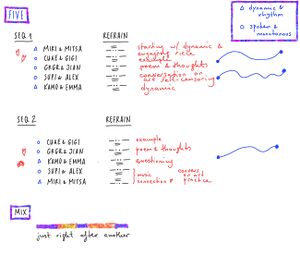
[interface] Supi was taking care of the interface and we were brainstorming about various solutions how to organise the content. After we received the texts, we started thinking about how can we organise the sequence visually - tried nesting, as a list, as a map. However, as soon as we got the recordings, we had to change our approach - there were many new elements to take into consideration before deciding on the sequence and the interface.
[release] The listening experience was quite important for us. We wanted not to show the website and people to watch a screen while listening to the broadcast, thus we facilitated a collective drawing moment. We invited everyone to sit together on a table and reflect on what they're hearing by sketching, doodling, writing and drawing.
[wip]
▶ care-takers working place
▶ editorial proposal to the group
05_02_ Contribution: What's Left To Discuss? [work w/ Supi]
[title] What Is Left To Discuss?
[duration] 3:05 min
[description] A conversation piece about art: what is it for us, as makers, how do we censor ourselves and why.
[input] audio recording of our voices; audio recording of noise made with Kastle
[tools] Kastle, Macbook pro, Zoom, Audacity
[process log]
- We started with some collective writing. The idea was to create a conversation by asking each other questions and answering them. We had an empty script with each of us writing something one after another.
- The text was created over 3 days. We both asked each other questions and answered them.
- Then, we recorded our conversation using an online call.
- In order to add an underscore, we produced various noises on Kastle at Supi's restaurant. Used one of them, looped it and added it to the mix.
- We had the idea to censor parts of our conversation. However, while listening to it, we decided to keep it as it is. It became a quite honest and open conversation and we shared things we wouldn't normally say in a conversation outside this setting.
week 06 - Diffractive Reading [work w/ Mitsa]
[title] Diffracted Narrations
[description] This simple recipe for diffractive perception of information provided by two sources can be used on various types of pieces. However, one of the inputs should be a video and the other one - a written text. We create a new piece by muting the original narration of the video and adding a completely different one. This method allows us to experiment on conceptual level: what types of stories or thoughts we would like to play with? By experiencing one source through the other, creative and unexpected readings can emerge.
[input] Video and written text. In our experiment we used Denise Fereira Da Silva, Arjuna Neuman (2019), Four waters: deep implicancy as a video source and two poems by Parwana Amiri: Your Eyes Bother Us and How Hard
[tools] computer, mobile phone
[process log]
▶ process pad
- Pick two pieces:
-one video (ideally without subtitles and texts on it)
-a written text (article, poem, short story etc.)
- Video: if the video has audio, mute it
- Text:
-choose part of the written text that you would like to add as a new voice over of the video
- Perform the new piece by playing the video and narrating it live yourself
- Record the performance with video & audio
As a result, you will have a new piece with a diffracted narration.
[output] Our diffracted narration - one of the takes (not the final choice of poems).
[reads] Denise Fereira Da Silva, Arjuna Neuman (2019), Four waters: deep implicancy
Parwana Amiri (2019-2020), Your Eyes Bother Us and How Hard
week 08 - Residency in Paris at La Generale [whole group work]
Paris residency with the whole group
recordings of the last release
experimental concert with Harold Schellinx + more info here
dj mixing session w/ Supi & Mitsa + prep for the live mix at the grad show
xpub2 grad show + live diffractive dj mix w/ Supi & Mitsa
Experiments
00. Notations w/ Carmen & Erika [Steve's class]
[about] During the activity we created notations which should be performed and recorded. Our trio, The Blind-Smashed-Orchestra had several ideas on which we made 5 different try-outs. Finally, we selected two of them: "the blind-smashed orchestra" and the "loop-stretch-cut". 20/04/2022
rec 1 blind-smashed-orchestra
instructions:
Imagine you are the conductor of an orchestra. Choose some musicians and form a circle with them.
start playing your masterpiece invoking the names of the instruments that will be given to each musician (f.e. you say drums looking at someone and this person will be in charge of the drums) The orchestra is a very special one. An orchestra of flat bodies laying on the ground. Blindfolded. Facing down. So as soon as you name the instrument the person in charge of it will crash on the ground and start improvise imitating that instrument. (you can choose between drums, winds, strings, vocals)
In the end join your musicians on the ground and direct your orchestra!
▶ recording
rec 2 loop-stretch-cut
instructions:
In a group of 3 people:
person 1 chooses a word and starts repeating it (as a loop)
person 2 waits a bit and starts stretching the word (as if it is stretched on Audacity)
person 3 waits a bit and starts to perform cuts of the word (as if it's cut on Audacity)
keep the performance for a while :-)
a special tribute to Manetta's homework assignment
▶ recording
rec Covers
We also did three covers of notations by Miriam and Emma:
Imagine you're the owner of a café and your coffee machine just broke down. You try imitating the sounds of a coffee machine so the customers won't notice that the coffee machine broke. ▶ recording
Hum the sound of a commercial jingle you know but with your mouth open. ▶ recording
Stare at the sun without sunglasses. Describe the feeling in a calm and juicy way.
▶ recording
01. How Does Anxiety Sound Like / individual work [prototyping]
[about] Our weekly assignment for the next prototyping class was to make a recording and use one (or more) of the effects on Audacity (repeat/stretch/cut/reverse) following some additional constrain. My first try was actually a longer piece coming from a personal need to explore some sounds and progression. Actually, I used almost all of the effects (except for reverse) for this piece:
▶ listen to how does anxiety sound like
▶ notation
[process] The core material is my voice saying "wow". Then, I changed the pitch to 2 levels down; 2 levels up and stretched them both with different rate. I repeated some of them and placed on different tracks, so they can overlap. Lower pitch sounds visualise the first signs of distress and the constant vibration/noise of the body after the climax. Higher pitches depict the moments of panic/histeria/fear or feeling of I cannot stand this anymore - the climax. Recorded and mixed on Audacity; computer microphone used.
02. Reversed Words / individual work [prototyping]
[about] Have you ever said something to a person you love that you wish you had never said? You cannot take your words back, can you? After doing the first experiment with the Audacity effects, I realised I didn't do anything with the "reverse" effect. I started thinking of what could be interesting to be reversed? Then, I quickly came up with the idea of reversing (as taking back) something you said. How would it sound to "delete" or "take back" what you said and immediately regretted. Here are some quick experiments:
▶ listen to reversed words
▶ notation
[process] First, I recorded my voice saying the three phrases. Then, I made the pitch one level down. Copied them and reversed. There is a tiny overlap between the "proper" phrase and the "reversed" one. There is another track with a slight sound on the background to fill in the silent moments between the three phrases. Recorded and edited on Audacity.
03. Intersections / individual work [Femke's class] [study week]
[assignment] diffractive reading
Pick two resources from the Related Resources page, and read/watch/... them "diffractively" through one another (i.e let them interfere with each other). Prepare a way to share some resonance for the afternoon session on Tuesday 7 June; duration p/p for doing this is maximum 5 minutes: A sound, an image, a quote, a performative response, an object, (it does not have to be durational) ... If you want to, you can take one resource from elsewhere but include at least one from the page. You can also pick materials that we watched/looked at together already.
[about] Intersection: Our future is somewhere here
For this assignment I have picked the following reads:
- Conversations with Edouard Glissant [2010] Documentary
- Wendy Hui Kyong Chun [2018] Queerying Homophily
This is an intersection between two works: thoughts of Edouard Glissant in the 2010's documentary about him and Wendy Hui Kyong Chun's chapter Queerying Homophily. It is based on similarity - what makes us similar and how does it affect the way we live (together). For Glissant, "we are in the same family when we share the same reactions and intuitions of the world (...) when we have the same manners". The roots can be found through poetry or knowledge. It is the common knowledge we accept from our parents and teachers (of any form) when we grow up. From the people we know and the events we experience. Thus, our predictions are "educated guesses" with the support of what we know, have seen, have read, have heard and experienced. When we look at the future, "we see the horizon through our imagination". The future we can create is the one we can imagine.
In the intersection of the present moment, we meet Wendy Hui Kyong Chun's collected data and grouped subjects with the help of similarity. Similarity breeds connection. She argues, "Homophily is the mechanism by which individuals “stick” together, and “wes” emerge". Predictions can be made thanks to the trained programmes which work with the collected data. However, "predictions can be “self-canceling” as well as self-fulfilling", she quotes Nate Silver. Thus, there are multiple possible futures. Everyone's imagination is bring one future and we collectively shape our collective future. Ours is somewhere in the fourth quadrant of the graph.
Terminology
Radio Implicancies is about practicing interdependencies. About how to stay with the complex entanglements between the personal, the economical, the political and the computational. About thinking, using and making technology with mutual relations in mind.
- agential realism
According to Barad's theory of agential realism, the universe comprises phenomena, which are "the ontological inseparability of intra-acting agencies". Intra-action, a neologism introduced by Barad, signals an important challenge to individualist metaphysics.
- homophily
Homophily is the principle that a contact between similar people occurs at a higher rate than among dissimilar people. The pervasive fact of homophily means that cultural, behavioral, genetic, or material information that flows through networks will tend to be localized.
- notation
A series or system of written symbols used to represent numbers, amounts, or elements in something such as music or mathematics.
Readings
- Barad, Karen (2007). Meeting the Universe Halfway: Quantum Physics and the Entanglement of Matter and Meaning
- Scratch Orchestra (1969) Nature Study Notes
- Simon Yuill (2008) All Problems Of Notation Will Be Solved By The Masses
- Mel Y. Chen (2012) Animacies: Biopolitics, Racial Mattering, and Queer Affect
- Roc Jiménez de Cisneros & Serafin Alvarez (2022) Are Viruses Alive?
- Larissa Lai, The Tiger Flu (chapter 1 + 2)
- Wendy Hui Kyong Chun (2018) Queerying Homophily
- Conversations with Edouard Glissant (2010) Documentary
- Denise Fereira Da Silva, Arjuna Neuman (2019), Four waters: deep implicancy
- Parwana Amiri, Your Eyes Bother Us, How Hard
Reflection
[personal reflection]
▶ structure & group work:
+weekly releases & structure of work organisation was great - no pressure of staying on one subject/project for long (work in groups of 3 or pairs rocks)
-not having guidance/structure makes us waste too much time in discussions and trying to make it work without leaving anyone out
+care-taking was quite exciting and a really great moment to play editor and experiment with concept
+the rotation of roles is an amazing opportunity to try out different things
-would adjust the weekly programme of days & work (mon prototyping/tue release was a bit difficult especially for care-takers)
▶ learning:
+experimental mode - felt that I had more time and opportunity to try out things than last two trimesters
+absolutely loved the way Femke facilitated the whole process & the sessions; she really has a unique and ultra valuable way to give feedback, put focus on and extract key points
+booklets by Manetta and Joseph were amazing
+weekly documentation really helped to record everything and quickly reflect on it
▶ collective moments & networking:
+Paris was a really great ending of the trimester and the year - it is also an opportunity for a regular collab (also so interesting their portable radio setup and concept, collective)
-going outside to practice and work with venues/collectives is super important
+the way we worked in Paris was really great
▶ special issue:
-addressing urgency was something we didn't really do during our work - we stayed on the safe place of playing with methods without going deeper into a topic; conversation about an issue - but then, we didn't really have time to do it
+but that was also ok - because we/many of us were exhausted from previous SIs and spending too much time on a big topic; maybe what we needed was not a topic, but more like adding more context in the releases; or maybe we didn't need to after all :)
-didn't open our publications to the public and I think we struggled with that during the whole year - we never really worked on how to connect with publics outside our room or bubble and didn't figure out that in our works and publications (at least I feel that) - e.g. in Paris when I saw their mobile radio setup I was talking with Carmen how amazing would it be if we had that
-I would really like to see more of connection with collectives and outside world of how things are applied in reality and made sustainable
-we are coming from different understanding & experience of what is a publication/publishing so a warm up moment in the beginning is essential (because of many reasons - culture, country, practice etc)
-felt disconnected from the prototyping classes this trimester (missed some because I got sick twice, then felt it's quite late to catch up)
-because of the weekly structure - focus on concept & less time for prototyping - usually when the time is short, you always focus on one thing
▶ general notes:
+we had the chance to change the structure for the last month - we decided to keep it as it is (maybe bc we were already tired?)
+a school trip is a must (once per year for both xpub1 and xpub2 I think)

